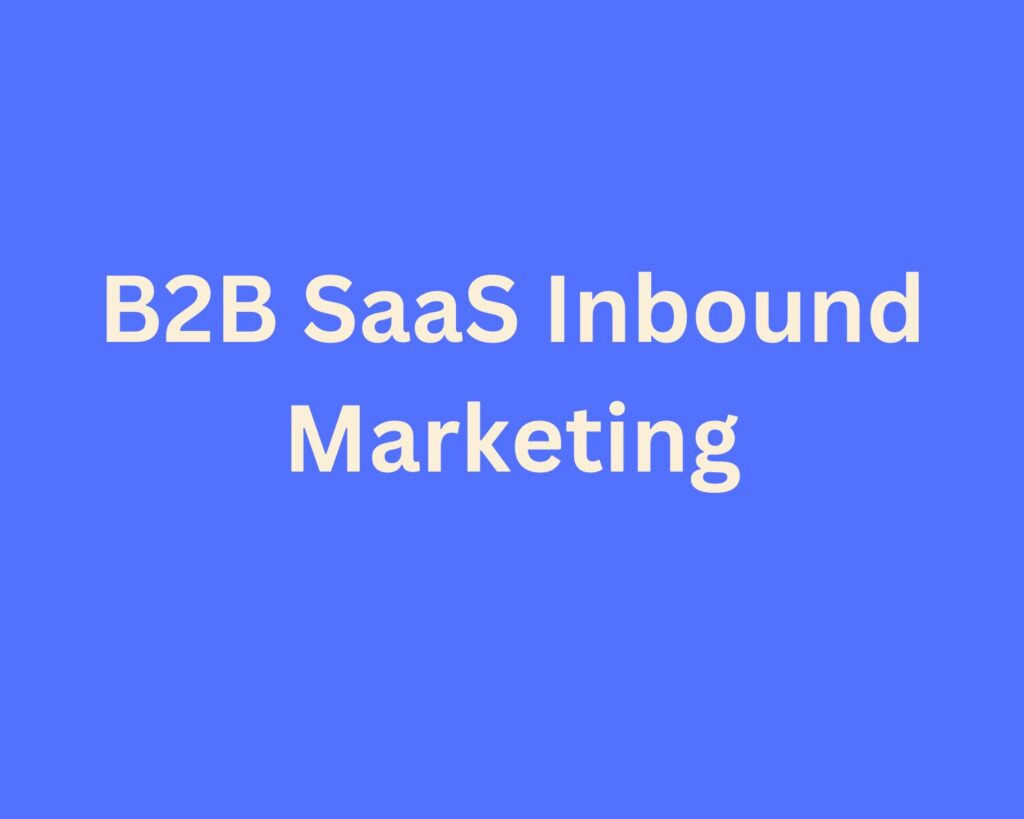In today’s highly competitive software industry, SaaS (Software-as-a-Service) companies are constantly looking for effective marketing strategies to attract, engage, and convert customers. One such strategy that has gained significant traction is B2B SaaS inbound marketing.
What is B2B SaaS Inbound Marketing?
SaaS inbound marketing can be defined as a strategic approach that focuses on creating valuable and relevant content to attract and engage the target audience. Unlike traditional outbound marketing tactics that interrupt and push promotional messages, inbound marketing aims to pull in potential customers through informative and compelling content. This approach aligns well with the buyer’s journey, helping software companies build trust, establish thought leadership, and ultimately drive conversions.
Importance of B2B SaaS Inbound Marketing
The importance of SaaS inbound marketing cannot be overstated. Here’s why it is a crucial strategy for SaaS companies:
1. Targeted Audience Engagement: SaaS inbound marketing allows companies to precisely target their ideal customers. By understanding their pain points, challenges, and preferences, SaaS companies can create content that resonates with their target audience, resulting in higher engagement and qualified leads.
2. Cost-Effective: Compared to traditional outbound marketing methods, inbound marketing offers a cost-effective approach. By investing in content creation, SEO optimization, and social media marketing, SaaS companies can attract organic traffic and generate leads without spending exorbitant amounts on advertising.
3. Long-Term Results: SaaS inbound marketing focuses on building a strong online presence, creating valuable content, and nurturing relationships with potential customers. Over time, this approach generates a steady stream of organic traffic, increases brand visibility, and establishes the company as an authority in the industry.
4. Lead Generation and Conversion: By offering valuable content, SaaS companies can capture leads and guide them through the sales funnel. Inbound marketing strategies such as gated content, email nurturing campaigns, and personalized experiences help convert leads into paying customers.
5. Measurable ROI: With the availability of various analytics tools, SaaS inbound marketing efforts can be accurately measured and analyzed. Companies can track key metrics, such as website traffic, lead generation, conversion rates, and customer acquisition costs, enabling them to optimize their strategies for better results.
Building an Effective SaaS Inbound Marketing Strategy
To create a successful SaaS inbound marketing strategy, it is essential to follow a well-defined approach. In this section, we will explore the key steps involved in building an effective SaaS inbound marketing strategy.
Identifying Target Audience and Buyer Personas
The foundation of any successful marketing strategy is a deep understanding of the target audience. For SaaS companies, it is crucial to identify the specific target audience and create buyer personas that represent their ideal customers. This involves conducting thorough research and gathering insights about their demographics, pain points, motivations, and preferences. By knowing your target audience inside out, you can tailor your content and messaging to resonate with their needs and interests.
Conducting Keyword Research and Optimization for SaaS
Keyword research plays a vital role in driving organic traffic to your SaaS website. By identifying the relevant keywords and phrases your target audience is searching for, you can optimize your website content, blog articles, and landing pages accordingly. This involves using keyword research tools, analyzing search volumes and competition, and incorporating the selected keywords strategically into your content. Effective keyword optimization helps improve your search engine rankings and increases your visibility among potential customers.
Creating and Optimizing Content for SaaS Inbound Marketing
Content creation lies at the heart of SaaS inbound marketing. It is crucial to produce high-quality, informative, and engaging content that addresses the pain points and challenges of your target audience. This can include blog articles, whitepapers, case studies, videos, webinars, and more. Focus on providing valuable insights, actionable tips, and solutions that showcase your expertise and establish your brand as a trusted authority in the industry. Additionally, optimize your content for search engines by incorporating relevant keywords, meta tags, and engaging headlines.
Utilizing Social Media Platforms for SaaS Marketing
Social media platforms offer a powerful avenue for SaaS inbound marketing. Identify the platforms where your target audience is most active and create a strong presence there. Develop a social media strategy that includes sharing your content, engaging with your audience, participating in relevant industry discussions, and promoting your SaaS offerings. Leverage the unique features of each platform to create compelling and shareable content that resonates with your audience.
Leveraging Email Marketing Strategies for SaaS Companies
Email marketing continues to be a highly effective strategy for nurturing leads and driving conversions in the SaaS industry. Build a targeted email list by offering valuable content downloads, gated resources, or newsletter subscriptions. Develop personalized and automated email campaigns that provide relevant content, updates, product information, and special offers to your subscribers. Focus on building strong relationships, addressing pain points, and guiding leads through the buyer’s journey.
Implementing Effective SEO Strategies for SaaS Websites
Search engine optimization (SEO) is critical for improving your SaaS website’s visibility and attracting organic traffic. Optimize your website’s technical elements, such as page load speed, mobile responsiveness, and site structure. Create informative and keyword-rich meta tags, headings, and descriptions. Build high-quality backlinks from reputable websites in the industry. Regularly monitor your website’s performance, track key SEO metrics, and make data-driven optimizations to enhance your search engine rankings.
Conversion Optimization for B2B SaaS Inbound Marketing
It involves several key strategies to maximize conversions and turn leads into customers. Some tactics include:
1. Designing high-converting SaaS landing pages: Creating visually appealing and user-friendly landing pages that highlight the unique value proposition of your SaaS product and encourage visitors to take action.
2. Creating compelling calls-to-action (CTAs) for SaaS products: Placing clear and persuasive CTAs throughout your website and marketing materials to guide visitors towards the desired conversion, such as signing up for a free trial or requesting a demo.
3. A/B testing and optimizing conversion funnels: Testing different variations of your website, landing pages, and CTAs to identify the most effective elements that drive conversions. Optimizing the conversion funnel involves streamlining the user journey and removing any barriers or friction points that may hinder conversions.
4. Utilizing marketing automation to nurture leads: Implementing automated email marketing campaigns and personalized content to engage and nurture leads throughout their buyer’s journey. This includes delivering targeted content, sending follow-up emails, and providing relevant offers to move leads closer to conversion.
Measuring and Analyzing Inbound Marketing Efforts
Effective measurement and analysis of SaaS inbound marketing efforts are crucial for optimizing strategies and driving meaningful results. In this section, we will explore the key steps involved in measuring and analyzing the performance of your SaaS inbound marketing campaigns.
1. Setting up SaaS Marketing Analytics:
To begin measuring and analyzing your B2B SaaS inbound marketing efforts, it’s essential to have a robust analytics framework in place. Here are some important steps to consider:
a. Define Goals and Objectives: Clearly articulate the goals and objectives of your inbound marketing campaigns. Are you aiming to generate qualified leads, increase website traffic, or improve conversion rates? Defining specific and measurable goals will help you track progress effectively.
b. Implement Tracking Tools: Utilize reliable tracking tools like Google Analytics or other analytics platforms that provide valuable insights into user behavior, traffic sources, conversions, and other relevant metrics. Ensure that the tracking code is correctly implemented across your website and landing pages.
c. Set Up Conversion Tracking: Track key conversion events such as sign-ups, demo requests, or purchases. Implement conversion tracking codes to monitor the effectiveness of your calls-to-action and lead-generation efforts.
2. Key Metrics to Track for SaaS Inbound Marketing:
Measuring the right metrics is crucial for understanding the success of your inbound marketing strategies. Here are some key metrics to track:
a. Website Traffic: Monitor the overall traffic to your website and identify the sources (organic, paid, social media) driving the most visitors. Track the growth trends and assess the impact of your marketing initiatives.
b. Conversion Rates: Measure the percentage of website visitors who take desired actions, such as signing up for a trial, subscribing to a newsletter, or becoming paying customers. Analyze conversion rates at different stages of the buyer’s journey to identify areas for improvement.
c. Customer Acquisition Cost (CAC): Calculate the cost of acquiring a new customer, including marketing expenses and resources involved. Comparing CAC with customer lifetime value (CLV) helps evaluate the efficiency and profitability of your marketing campaigns.
d. Return on Investment (ROI): Assess the financial return generated by your inbound marketing efforts. Measure the revenue generated relative to the costs incurred, including both direct and indirect revenue attributed to your marketing campaigns.
e. Engagement Metrics: Analyze engagement metrics such as time on page, bounce rate, and page views per session to gauge the quality and relevance of your content. Identify which pages or assets are performing well and optimize those that need improvement.
3. Analyzing Data and Making Data-Driven Decisions:
Data analysis plays a vital role in refining your B2B SaaS inbound marketing strategies. Here’s how to leverage data for data-driven decision-making:
a. Identify Patterns and Trends: Explore the data collected from your analytics tools to uncover patterns, trends, and correlations. Look for insights into which marketing channels, campaigns, or content formats are driving the highest engagement and conversions.
b. Conduct A/B Testing: Test different variations of landing pages, CTAs, email subject lines, or ad copies to determine which elements resonate best with your target audience. A/B testing allows you to make data-backed decisions and optimize your campaigns for better results.
c. Optimize Conversion Funnels: Analyze the performance of your conversion funnels to identify bottlenecks or areas where prospects drop off. Make necessary adjustments and improvements to optimize the flow and increase conversions at each stage.
d. Continuously Refine Strategies: Use the insights gained from data analysis to refine your SaaS inbound marketing strategies. Implement iterative improvements based on data-backed decisions and continue monitoring and analyzing results to drive ongoing success.
Common Challenges in Inbound Marketing and How to Overcome Them
While SaaS inbound marketing can be highly effective, it also presents unique challenges that require strategic solutions. In this section, we will discuss some common challenges in SaaS inbound marketing and provide strategies to overcome them.
1. Overcoming Limited Resources and Budget Constraints
One of the most prevalent challenges in B2B SaaS inbound marketing is dealing with limited resources and budget constraints. Here’s how you can overcome this challenge:
a. Prioritize and Focus: Identify the marketing channels and strategies that provide the highest return on investment (ROI) for your SaaS product. Allocate your resources strategically by focusing on tactics that have proven to be effective in reaching and engaging your target audience.
b. Embrace Content Marketing: Content marketing can be a cost-effective approach for SaaS companies. Create valuable and engaging content that educates and solves problems for your target audience. Leverage various content formats such as blog posts, videos, infographics, and ebooks to maximize your reach without breaking the bank.
c. Leverage Partnerships and Collaboration: Look for opportunities to collaborate with complementary businesses or influencers in your industry. This can help you tap into their existing audience and expand your reach without significant financial investments. Explore co-marketing initiatives, guest posting, or joint webinars to mutually benefit from shared resources.
2. Generating High-Quality Leads
Another common challenge in SaaS inbound marketing is generating high-quality leads that are more likely to convert into paying customers. Here’s how you can overcome this challenge:
a. Understand Your Ideal Customer: Develop detailed buyer personas to understand the pain points, motivations, and preferences of your target audience. This will enable you to create tailored content and messaging that resonates with them and attracts qualified leads.
b. Optimize Conversion Funnels: Continuously analyze and optimize your conversion funnels to minimize friction and improve lead quality. Streamline your forms, simplify the signup process, and offer clear value propositions to encourage conversions. Use lead scoring techniques to prioritize and focus on leads with the highest potential.
c. Nurture Leads with Personalized Content: Implement lead nurturing strategies to guide leads through the buyer’s journey. Send targeted and personalized content based on their specific interests and behavior. Utilize email marketing automation tools to deliver relevant content at the right time and nurture leads until they are ready to make a purchase decision.
3. Staying Ahead of the Competition
In the competitive landscape of SaaS, it’s crucial to differentiate your brand and stay ahead of the competition. Here’s how you can overcome this challenge:
a. Conduct Competitor Analysis: Analyze your competitors’ marketing strategies, messaging, and positioning. Identify gaps in the market and areas where you can offer unique value. Differentiate your SaaS product by highlighting its key strengths and features that set it apart.
b. Build Thought Leadership: Establish yourself and your brand as a thought leader in your industry. Publish insightful blog posts, contribute guest articles to reputable publications, and participate in industry events and conferences. Position yourself as an expert and provide valuable insights that establish credibility and attract attention.
c. Leverage Customer Testimonials and Case Studies: Social proof is a powerful tool in SaaS marketing. Collect testimonials and case studies from satisfied customers and showcase them on your website, social media, and other marketing channels. Highlight the success stories and positive experiences of your customers to build trust and credibility.
Wrapping Up
Effective inbound marketing strategies are crucial for the success of SaaS companies. Key takeaways include prioritizing SaaS-specific methodologies, focusing on customer retention and upselling, creating valuable and optimized content, strategically promoting content, personalizing communication and engagement, and continuously optimizing strategies. By addressing common challenges and embracing the power of inbound marketing, SaaS businesses can drive meaningful results and accelerate growth.
Get in touch with the Gignaut team today to start measuring and improving your marketing efforts.
Check the B2B SaaS Marketing Handbook to learn more.
Uzma is a Professional Content Writer and Certified Digital Marketing Expert





